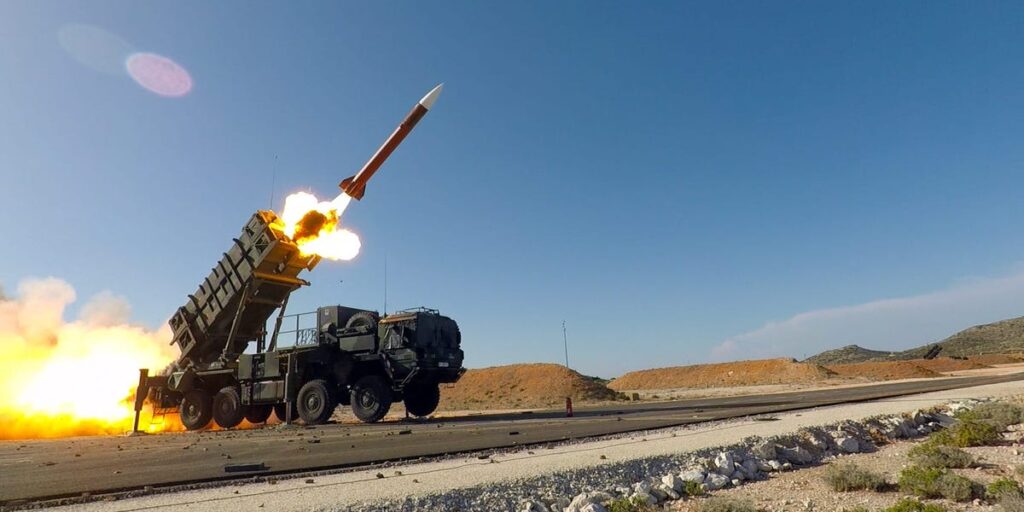American defense companies are cranking out Patriot interceptors at a record-breaking pace, but demand is surging.
Russian missiles are stressing Ukraine’s Patriots, leaving it scrambling for more ammo. Iranian missiles have put batteries in the Middle East to the test. Western Europe is realizing it needs to revitalize its depleted air defenses, and the US is recognizing that key stocks are running low and need to be not just refilled, but dramatically expanded.
Amid global conflicts and growing worries in the West about a major conflict against a peer-level adversary, air defense missiles are in huge demand.
It has driven the companies making the launchers, missiles, seekers, and more, defense companies like Lockheed Martin, Raytheon, and Boeing, to ramp up their production, but the demand is also up. And in a high-end fight, it could skyrocket.
Surging production is battling surging demand
Patriot batteries are made up of radar and control systems, launcher stations, and interceptor missiles, which altogether make up what is considered to be one of the world’s best air defense systems. The weapon can effectively detect and intercept ballistic missiles, cruise missiles, drones, and aircraft.
Last year, the US Army awarded Lockheed Martin, which makes the Patriot’s PAC-3 MSE interceptor missiles, a contract to bring annual output to 650. It sat at 350 only a few years ago.
Interceptor production hit a record-breaking 500 last year, and Lockheed Martin is on track this year to produce more than 600 PAC-3 MSEs for the first time. The company said there would be a “significant increase” for 2027.
Meanwhile, Boeing is surging PAC-3 missile seekers, critical components that enable the Patriot system to identify, track, and intercept threats, and Raytheon, which makes Patriot radars and launchers, is boosting PAC-2 interceptor missile production.
The global annual production of Patriot missiles is estimated to be somewhere around 850 to 880 per year, according to Fabian Hoffman, an air defense and missile expert at the University of Oslo. That number could hit 1,130 by 2027.
Russia, far from the only adversarial nation the West is worried about, is estimated to be producing roughly 840 to 1,020 of its 9M723 Iskander short-range ballistic missiles and the air-launched Kh-47M2 Kinzhal short- to medium-range ballistic missiles a year. Those weapons are only two missiles in a vast arsenal.
That imbalance leaves the West with a concerning math problem. Air defenders tend to need to fire two or three interceptors to reliably take out one incoming threat, making things even more complicated. Patriot isn’t the only air defense game in town, but it’s a key capability that could be stressed without deep stockpiles.
Brian Kubik, vice president of PAC-3 programs at Lockheed Martin Missiles and Fire Control, told Business Insider that “Lockheed Martin recognizes the critical need for PAC-3 MSE, and we’re working closely with the US Army and suppliers to increase our production rate to meet the worldwide demand.”
“Our robust infrastructure and supply chain provide a strong foundation for increasing production,” he explained, adding that the company is “taking proactive steps and making internal investments to help support our suppliers, accelerate delivery, and decrease production roadblocks.”
Raytheon told Business Insider that “it’s more important than ever to co-produce, co-develop, and collaborate to get the best capabilities to the field quickly.”
It said it has entered into new partnerships to increase production, is increasing its staff, and has also committed nearly $1B to secure critical materials from suppliers and ramp manufacturing for Patriot radars. The company said that “by the end of 2025, Raytheon, along with our suppliers, will accelerate delivery times for Patriot radars by 25%.” Patriot GEM-T interceptor production will increase by 150% by 2028, it added.
Hoffman cautioned that even if the West’s production of missile interceptors, like the Patriots, exceeds Russian conventional ballistic missile production, “this will not solve Europe’s problems.”
And for the US, the threat isn’t Russia alone. The Pentagon is eyeing China’s growing ballistic missile arsenal and recognizing that it is going to need substantial air defenses. American allies in the Pacific realize that, too. And foes in the Middle East can’t be dismissed.
Patriots are used by European allies, as well as allies and partner nations in Asia and the Middle East. There are 19 operators worldwide, and that means a lot of competing demand, especially with some nations at war.
The West’s increased production is starting at a time when interceptor stockpiles appear to be running low in the West, putting extra pressure on production efforts. The challenge in fixing the problem is that the Patriot missiles and batteries take time to make, and in that time, immediate demands compete heavily with stockpiling needs for future fights.
Thomas Laliberty, Raytheon’s president of land and air defense systems, said last year that “it takes us 12 months to build a Patriot radar, but it takes us 24 months to get all the parts.” Meeting global demand often means pulling from existing stockpiles, for both launchers and missiles alike.
Strained stockpiles
The Pentagon rejected a report from The Guardian last month that said that the US only has about 25% of the Patriot interceptors it needs. Pentagon spokesperson Lt. Col. Bryon McGarry told Business Insider that “the US military has what it needs to fight and win any mission, anywhere, anytime.”
At the beginning of last month, however, the Pentagon abruptly paused weapons shipments to Ukraine, including Patriot interceptors, amid concerns about US weapons stockpiles. The move was reportedly triggered by Elbridge Colby, the undersecretary of defense for policy and someone who has long been deeply vocal about insufficient US readiness for war with China.
Trump reversed the decision on military aid but changed how weapons are being provided to Ukraine, putting cost and stockpile burdens on European allies while the US handles production.
Prior to that back-and-forth, the president commented on the Patriots during a press conference, telling a Ukrainian journalist that while the US might be able to get additional systems to Ukraine, “they’re very hard to get.”
“We need them too,” Trump said in late June.
Though the Pentagon rejected assertions that there is a problem, US officials have previously suggested that there is at least strain.
US Navy Adm. Samuel Paparo, the head of US Indo-Pacific Command, said last year that the fighting in the Middle East and Ukraine was eating into the US stockpile, pulling assets away that would be needed in a fight in his priority theater.
The admiral said that “to say otherwise would be dishonest.”
Gen. James Mingus, the vice chief of staff of the Army, said earlier this month that US Patriot battalions as “a very stressed force element.”
David Shank, a retired Army colonel and the former commandant of the Army Air Defense Artillery School at Fort Sill, Oklahoma, shared with The War Zone that the US was short on Patriot interceptors even in 2021, before Russia’s full-scale invasion of Ukraine.
The war, he explained, has exacerbated longstanding problems with missile stockpiles.
There’s a clear effort underway to expand US Army stocks as the service aims to quadruple its purchase of interceptors, from 3,376 to 13,773, with a substantial $1.3 billion investment in Patriot missiles, a move that reflects repeated calls from experts and officials for far deeper magazines.
What conflicts are showing about the need for air defenses
Recent conflicts, specifically the massive missile and drone attacks in Ukraine and in the Middle East, are driving the new demand and showing how critical air defenses are in modern warfare.
Ukraine has used its Patriots to protect cities and military infrastructure and to shoot down a Russian aircraft, but it’s always in search of more batteries and interceptors. Germany has agreed to provide more, but only on the condition that the US replaces them in six to eight months. There’s not enough capacity in existing stocks to easily spare. That means greater demand on producers.
NATO is becoming increasingly aware of the value of air defenses. Its secretary general, Mark Rutte, said increased defense spending — an alliance push to spend 5% of GDP on defense — would support a huge “fivefold increase in air defense capabilities.”
He said that the way Russia is fighting shows why these weapons need to be a top priority. “We see Russia’s deadly terror from the skies over Ukraine every day, and we must be able to defend ourselves from such attacks,” he said.
Read the full article here
















